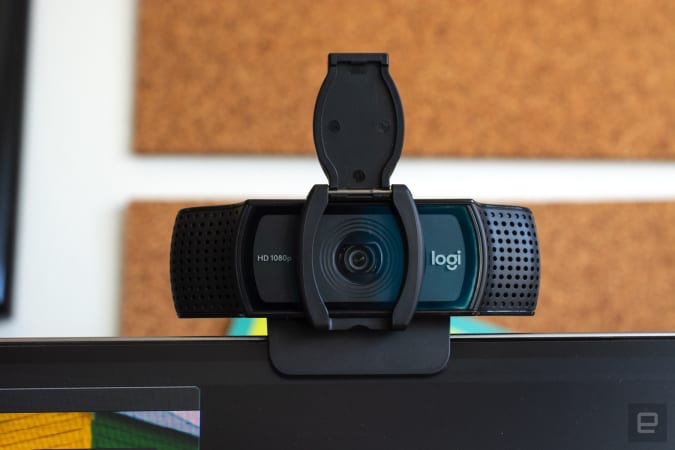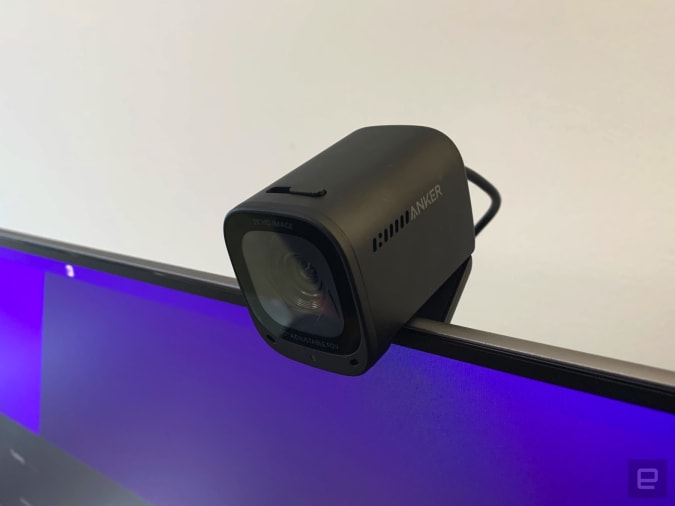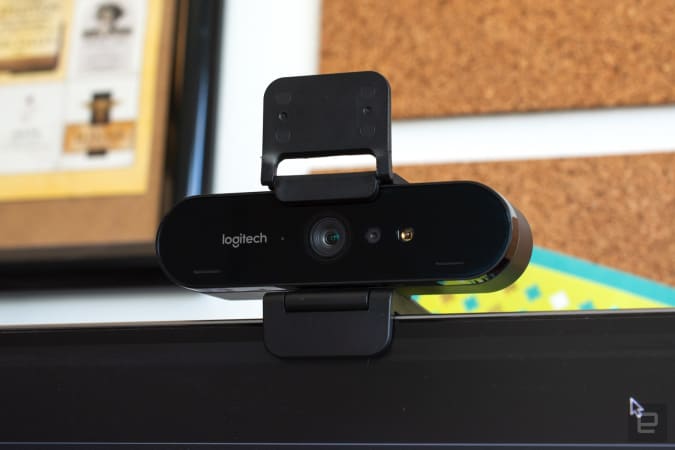The best webcams you can buy
All products recommended by Engadget are selected by our editorial team, independent of our parent company. Some of our stories include affiliate links. If you buy something through one of these links, we may earn an affiliate commission.
That tiny webcam on your laptop has probably gotten more use in the last few years than it ever has before. Even if you’re back to taking some of your meetings in the office, chances are that back-to-back Zoom calls are now a permanent part of your professional life. Once an afterthought, your computer’s webcam has become one of its most important components — and the fact remains that most built-in cameras are not able to provide consistent, high-quality video chat experiences.
This is where external webcams come in. They can do wonders for those with lackluster built-in webcams, people who spend most of their working hours on video conferences, and those who picked up a new hobby of streaming on Twitch or YouTube over the past couple of years. But as with most PC accessories, it can be tough to sort through the sea of options out there. We tested out a bunch of the latest webcams to see which are worth your money and which you can safely skip.
What to look for in a webcam
Resolution and field of view
While some newer machines have 1080p webcams, most built-in cameras have a resolution of 720p, so you’ll want to look for an external one that’s better than that. FHD webcams will give you a noticeable bump in video quality; ideally, you’re looking for something that can handle 1080p at 60fps or 30fps. If you’re considering a cheap 720p webcam, make sure to get one that supports at least 30fps (most will) or, even better, 60fps. However, if your primary concern is looking better during video calls, 1080p is the way to go.
Some webcams can shoot in 4K, but that’s overkill for most people. Not to mention most video conferencing services like Zoom, Google Meet and Skype don’t even support 4K video. When it comes to streaming, Twitch maxes out at 1080p video, but YouTube added 4K live streaming back in 2016. Ultimately, with 4K webcam shots having such limited use, most people can get by with a solid 1080p camera.
Field of view controls how much can fit in the frame when you’re recording. Most webcams I tested had a default field of view of around 78 degrees, which was enough to capture me and enough of my background to show that I really need to organize my home office. On cheaper webcams you’ll usually see narrower fields of view (around 60 degrees), and those aren’t necessarily bad. They won’t show as much of your background, but that also means you won’t be able to squeeze as many friends or family members into frame when you’re having Zoom birthday parties. On the flip side, more expensive webcams may let you adjust the field of view to be even wider than average.
Valentina Palladino / Engadget
Autofocus and other “auto” features
Webcams with autofocus will keep you looking sharp without much work on your part. You should be able to move around, step back and forth, and remain in focus the whole time. Some models let you manually adjust focus, too, if you have specific needs. Devices with fixed focus are less convenient, but they tend to be more affordable.
In the same vein is auto framing, a feature that some high-end webcams now offer. Similarly to Apple’s Center Stage feature, the camera automatically adjusts to keep you in the center of the frame even as you move around. But you’ll pay a premium for it: The only two webcams I tested that had auto framing were the $200 Dell UltraSharp webcam and the $220 Anker Video Bar, and while that helped those models stand out from the pack, neither were great enough to earn a spot in our best picks list.
You’ll also see other “auto” features listed in webcam specs, most notably auto light correction. This will adjust the camera’s settings to make up for a dimly lit room. If you don’t have a well-lit setup for your video calls, or often take calls in different places where you can’t control the lighting, this feature will be valuable.
Microphones
Most webcams have built-in microphones that, depending on your setup, might end up being closer to you than your computer’s own mics. Check to see if the model you’re considering has mono or stereo mics, as the latter is better. Some even use noise-reduction technology to keep your voice loud and clear. While audiophiles and streamers will want to invest in a standalone microphone, most others can get by using a webcam’s built-in mic.
Design
There aren’t a ton of fascinating breakthroughs when it comes to webcam design. Most are round or rectangular devices that clip onto a monitor or your laptop screen. Some have the ability to screw onto a tripod stand and others can simply sit on your desk beside your computer. But unless you really like having people stare up your nose, the latter isn’t ideal. We recommend clipping your webcam to your monitor and ensuring that it’s at or slightly above eye level.
A few webcams go above and beyond by adding hardware extras like built-in lights and lens covers, too. The former can help you stand out in a dark room, while the latter makes it so hackers can’t view you through your webcam without your knowledge.
Price
Most external webcams that are just good enough to be a step up from your computer’s built-in camera cost between $60 and $150. If the webcam has the same resolution as the internal one on your laptop, you should look out for other specs like auto light correction, a wider field of view or an extra-long connecting cable that can provide a step-up in quality or ease of use.
Spending $150 or more means you might get advanced features like 4K resolution, vertical and horizontal recording options, stereo mics, customizable video settings and more. But unless you’re spending hours on video calls each day or streaming multiple times each week, you can safely skip most of those high-end options.
Engadget picks
Best overall: Logitech C920s Pro HD

Valentina Palladino / Engadget
The Logitech C920s Pro HD webcam seems like a great value on paper, and it proves that to be true, too, once you take it out of the box. For around $60, you’re getting an FHD webcam that can shoot in up to 1080p/30fps, has a 78-degree field-of-view, dual microphones and auto light correction. It’s a fairly average-looking webcam measuring 3.7 inches at its widest point, with the lens in the middle and its two microphones on either side.
Buy Logitech C920s Pro HD at B&H – $70
The adjustable base is quite sturdy and, while I kept it hooked to my external monitor most of the time, you could easily attach it to your laptop’s screen or sit it on your desk and angle the camera upward. There’s also a hole on the underside if you wish to connect it to a tripod. There’s an optional lens cover in the box that provides protection when you transport the webcam, but also gives you extra privacy.
I immediately saw an improvement in video quality when I took conference calls using the C920s Pro HD. I’m lucky enough to have one lamp and one large window in my small home office, so I’m usually not fighting for good light. But even on cloudy days, the camera’s 1080p video was sharp and produced fairly accurate colors. While cheaper cameras struggled on rainy days with the lamp off, the C920s Pro HD illuminated my whole face and had minimal shadows.
All Logitech webcams can use the company’s Camera Settings app to adjust things like field of view, brightness, color intensity and autofocus, but I kept the default settings on this one. The C920s Pro HD does have autofocus and it was so good that I barely noticed it. I was always in focus during my video chats and I never saw the camera struggling to regain focus even if I moved around.
Runner Up: Anker PowerConf C200

Valentina Palladino / Engadget
Anker’s cube-like PowerConf C200 webcam has a lot of the same perks as Logitech’s C920s Pro HD, along with a few extras and a price tag that’s $10 more. Setup is equally as easy as with the Logitech cam – just plug it into your computer or docking station and start using it. You can download the AnkerWork software to edit things like brightness, sharpness and contrast ratio and, as with Logitech’s, I kept all of those settings at their defaults.
Buy PowerConf C200 at Amazon – $70
But you’re also able to control the camera’s resolution and field of view with this software, too. The C200 webcam defaults to a 2K resolution, but you can bring it down to 1080p, 720p or even 360p if you wish. Same goes for field of view: The default is 95 degrees, but I bumped mine down to 78 degrees to spare my colleagues a wider view of my messy home office.
I was immediately impressed with the C200’s video quality: 2K is likely more than most people need (1080p should do just fine), but the extra sharpness and clarity is a nice touch. The webcam’s autofocus is quite fast, and its larger f/2.0 aperture captures more light so you stay illuminated even in darker settings.
In addition to a built-in lens cover that you can slide closed for privacy, the C200 has dual stereo mics that actually do a good job of capturing your voice loud and clear. You can also choose directional or omnidirectional vocal pickup in the AnkerWork settings, with the latter being better if you have multiple people speaking on your end.
My biggest complaints about the C200 webcam are that it’s a bit cumbersome to adjust its angle when it’s perched on your monitor or screen. Unlike most other webcams, Anker’s doesn’t have a short neck of sorts that connects the camera to its adjustable base – it’s just one, chunky piece of plastic that I had to use both hands to adjust when necessary. Also, the C200 comes with a USB cable that’s much shorter than others. This won’t be a problem if you’re connecting the webcam directly to your laptop, but it’s not as flexible if you have a standing desk converter or a more complicated setup that requires long cables.
Best for streaming: Logitech Streamcam

Valentina Palladino / Engadget
Of all the webcams I tested, I had the most fun using Logitech’s Streamcam. While it’s a bit weird to say I “had fun” with such an innocuous piece of tech, I found the Streamcam to be remarkable in many ways. First and foremost, the video quality is excellent: It shoots in 1080p/60fps and its video is slightly sharper than that of the Logitech C920s Pro HD. Details in my clothing came through much better and, whether I liked it or not, so did some of the texture on my skin. The Streamcam was also one of the best devices when it came to color reproduction.
Buy Logitech Streamcam at Amazon – $170
All of those perks remain the same even when you’re shooting in low-light conditions. The Streamcam’s auto-exposure feature made up for the darkness in my office on gloomy days. And it has the best kind of autofocus — the kind that you never notice in action.
The dual omnidirectional mics inside the Streamcam delivered my voice loud and clear during video calls. If you stream often and find yourself without an external mic, it’s nice to know that you could get by with the Streamcam’s built-in ones in a pinch. The microphones also have noise reduction to keep your voice font and center.
As far as design goes, the Streamcam is a bit larger than most. It’s a chunky almost-square that can easily be positioned on a monitor or on a tripod, and a unique feature of its design is its ability to shoot either vertically or horizontally. I kept mine in the standard 16:9 format, but some streamers who post to social media often will like the 9:16 format that’s best for Instagram and TikTok. Logitech also made sure the Streamcam was optimized for Open Broadcaster Software (OBS), XSplit and Streamlabs, so you can use it directly out of the box for your next live session.
The Streamcam is the best all-purpose webcam on our list; if you want one device that can do it all, from video conferences to Twitch streams to family video chats, the Streamcam is the best option. However, not everyone will want to drop the $170 on one. Its higher price keeps it from our top spot because those who just want to look better on Zoom calls don’t need to drop $170 to do that.
Best premium: Logitech Brio

Valentina Palladino / Engadget
If you’re willing to spare no expense on a webcam, Logitech’s $200 Brio is the one to get. It has a lot of things going for it, but the best and most important feature is its 4K recording. It’s capable of shooting in 4K/30fps in addition to 1080p and 720p in either 60fps or 30fps. I kept it set at 4K and I never looked better on a video call. My feed was sharp and clear, and the only negative thing about it was the slightly inaccurate colors (they came off more saturated than normal).
Buy Logitech Brio at Amazon – $200
Low-light performance was stellar as well. The Brio’s light correcting technology with HDR made up for the cave-like environment in which I was sometimes forced to record. As far as sound goes, the dual microphones inside the Brio were some of the loudest and clearest of any webcam I tested. They also use noise-canceling technology to capture audio from up to one meter away while blocking out background noise.
The Brio also had the most customizable settings of the Logitech cameras I tried. In addition to brightness, contrast, color intensity, white balance and autofocus, you’re able to adjust HDR, field of view and image ratio in the Camera Settings app. While I kept most of the default settings, I changed my field of view from 65 degrees to 78 degrees (the third option of 90 degrees was too wide for my taste), and it captured just enough of my background but still kept me as the focal point.
I also opted to turn off autofocus because I found it to be finicky. Issues with the Brio’s autofocus have been documented online and I’ve reached out to Logitech for troubleshooting tips. An Engadget colleague who uses the Brio as his daily webcam hasn’t experienced the autofocus issues, so there just might not be enough contrast between myself and the background. Since I take most video calls from my home office desk, adjusting the focus manually to fit that environment worked well for me.
It’s hard to get excited about webcam design, but Logitech tried to make the Brio as sleek looking as possible. Instead of a mere rectangle, the Brio is an elongated oval with rounded edges and a standard base that clips securely onto a screen. The front is a glossy black, punctuated only by the camera lens, two tiny slits for the microphones and the IR sensors. The latter makes the Brio compatible with Windows Hello, so you can unlock your system using facial recognition. And when you want more privacy, you can use the included lens shade to cover the camera.
For all the latest Technology News Click Here
For the latest news and updates, follow us on Google News.
